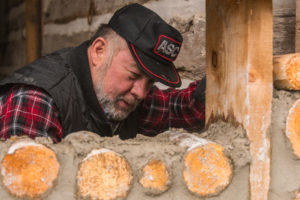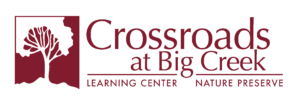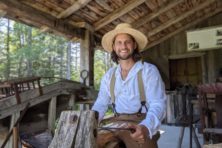Cordwood Masonry Construction at Heritage Village
- Share
- Tweet
- Pin
- Share

Brothers Mike, Pat and Steven Madden have been working on building the Madden Tool Museum at the Heritage Village at Big Creek with the help of volunteers. They chose to go with cordwood masonry construction – sometimes known as “stovewood” or “stackwall” construction.

Mike Madden works on the cordwood sections of the barn construction at Heritage Village in Sturgeon Bay.
Cordwood masonry is a natural building method that can be traced 1,000 years back in Europe and to the 1800s in North America. The American Institute of Architects refers to this type of building as “vernacular construction” and considers it a sustainable style because it relies mainly on locally available renewable materials.
The Maddens took their inspiration for the project from local historian George Evenson.
“George Evenson always wanted an example of that type of construction at Crossroads, because this is quite unique to this area. He was kind of our motivator to do that,” said Mike Madden.

Pat Madden (brown shirt), Steve Madden (blue shirt), Mike Madden (flannel) and Dan Hanson (grey).
It took them 2½ years to complete the approximately 150 square feet of cordwood building.
“We had never done it before and we’re pretty pleased with the results,” Madden said.
Next up for the building? Madden said they would like to add a porch, and some interior lighting, and then on to displays for the hand tools. They are also actively seeking hand tool donations for the museum.
“We are seeking hand tools from the era of the late 1800s to about 1920,” Madden said.
When the Maddens held a media day recently to show the work, Mike Madden handed out an article from Mother Earth News that explains the charm and sustainability of cordwood masonry construction.
- Ease of construction: To lay up a cordwood wall, the builder need never handle anything heavier than a firewood log. Mortar is easily mixed in a wheelbarrow.
- Economy: Log ends can be cut from less-than-perfect or salvaged wood. Even old fence rails and driftwood have been used.
- Energy advantages: Cordwood combines insulation with thermal mass better than any other above ground building system. The secret is the unique insulated mortar matrix that is woven around all of the log ends. The mortar does not conduct heat directly through the wall because of an insulated cavity built into the middle third of the wall. Cordwood walls contain tremendous thermal mass in the mortar. The log ends themselves also possess both insulative and thermal mass characteristics. Because of this, cordwood homes do not suffer from wild temperature fluctuations; they are easy to keep warm and stay comfortably cool in the summer.
- Environmental harmony: Cordwood masonry makes use of natural, indigenous materials, and even “waste” that was destined for the landfill.

Pat Madden splits and debarks the cordwood using some of the antique tools donated to the tool museum.



